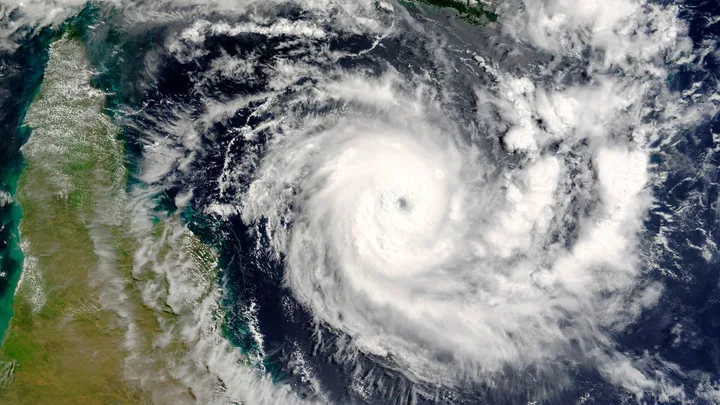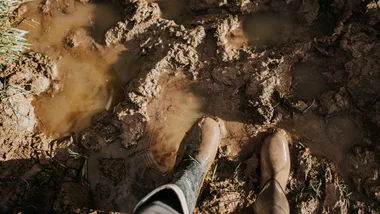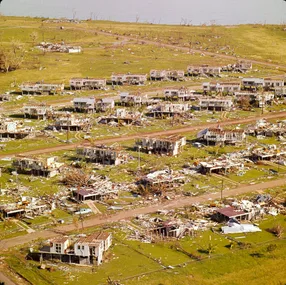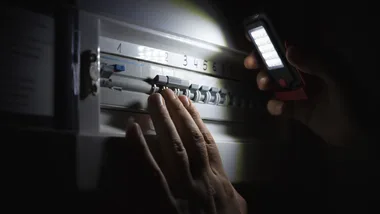In Australia, the tropical cyclone season is from November to April. Here’s everything you should know about how to prepare for a cyclone.
Just as Australians are recovering from the effects of Cyclone Alfred in Queensland and New South Wales, news is brewing that we should brace for another cyclone, this time on the west coast.
Weatherzone has reposted that there is a high likelihood of another tropical cyclone near the northwestern coast of Western Australia.
The Bureau of Meteorology (BoM) has stated that the likelihood of “severe (strong) tropical cyclones is higher than average” this season. We have had nine cyclones since December, the highest amount in three years. If we received three more named cyclones this season, it would be the most cyclones we’ve had in a single season in 19 years.
Due to our geographic location and rising water temperatures, cyclones are likely to continue to be a growing threat to Australians. It’s time for us to ensure we’re prepared for when it does.
Know your risk
Cyclone season is from 1 November to 30 April. Keep an eye on weather reports, news updates, and local government announcements to stay aware of whether your location is affected by an incoming cyclone or flooding.
The Bureau of Meteorology (BoM) have a tropical cyclone tracker map, which you can check in on to know whether you are at risk or not.

Make a plan
It’s imperative to have a plan in place in case you are caught in an emergency to make sure you don’t waste time scrambling.
When a cyclone warning is issued, take immediate action by securing your home, closing and reinforcing windows and doors, and moving valuables and electronics to higher ground if there is a risk of flooding.
Since power outages are common, charge your phones, power banks, and emergency lights, and keep a battery-powered radio on hand for updates. Have an evacuation plan in place, knowing the nearest shelter and the safest routes, and prepare a “go bag” with essential items in case you need to leave quickly.
Have an evacuation plan. Know where the nearest evacuation centre is and how to get there. Arrange with neighbours to carpool if necessary. Speaking about neighbours, check in on them, especially if they are vulnerable or have any mobility issues.
How do I prepare my house for a cyclone?
Preparing your house for a cyclone is essential to minimise damage and ensure safety. Ahead of cyclone season, inspect and reinforce your roof, ensuring there are no loose tiles or sheets and securing it with cyclone straps if needed.
Windows and doors should be strengthened with shutters or plywood, and additional bolts or braces can help keep doors intact during strong winds. Fun fact: taping an “X” on your windows does little to actually protect them. In fact, if the windows do break, the tape can cause large shards to form, which could be more dangerous.
Clearing the surroundings by trimming trees and securing or storing outdoor furniture, tools, and other loose objects will prevent them from becoming dangerous projectiles. Additionally, clean gutters and ensure proper drainage to reduce the risk of flooding.

Sandbags can help prevent flooding by redirecting and blocking water from entering your home. Emergency services often provide sandbags for people’s use during storm season.
Fill your bathtub, bottles, and buckets with water so you and your family have access to clean water for drinking and also to ensure you can keep essentials like toilets running if the water supply is affected.
Where is the safest place to take shelter?
If you are past the time to evacuate, the safest place to take shelter is in your own home. Conditions can change rapidly, so if there’s a stay-at-home mandate, listen to it. Flying debris and sudden wind gusts can be extremely dangerous.
The best place to shelter in your home is a small windowless room like a bathroom, pantry or walk-in wardrobe, or even a built-in if it’s roomy enough. Avoid rooms with windows or external doors. For more protection, you could take cover under a mattress or solid piece of furniture like a dining table.
Pack a kit
Stocking up on emergency supplies is crucial. Prepare a kit with essentials such as non-perishable food, water, medications, flashlights, extra batteries, a first aid kit, and important documents stored in waterproof bags. Don’t forget any baby supplies or pet food if you need it.
Before you head to the supermarkets, see what you have in your pantry and freezer that could see you through a few days. If big supermarkets are closed, try local stores or petrol stations for supplies.
What’s a storm surge?
A storm surge is when sea levels rise rapidly due to a cyclone or strong storm. It happens when powerful winds push ocean water toward the shore, causing it to pile up and flood coastal areas. This surge can be several meters high and, when combined with high tides, can lead to devastating flooding, erosion, and destruction of buildings and infrastructure.
As mentioned, it causes water levels to rise rapidly, which is especially dangerous as it leaves little time for evacuation. To stay safe, follow evacuation orders if they are issued, move to higher ground if you can, and avoid coastal areas.

What’s the difference between a cyclone and a hurricane?
With all the different terminology blowing about, it can be hard to keep it straight. But essentially, hurricanes are tropical storms in the northern hemisphere — so they form over the North Atlantic and Northeast Pacific Oceans — and cyclones are tropical storms that form in the southern hemisphere over the South Pacific and Indian Oceans. Typhoons are different again. They are tropical storms that form over the northwest Pacific Ocean.
Due to the Coriolis effect (caused by Earth rotating on its axis), hurricanes in the northern hemisphere spin right to left (or west to east), and cyclones in the southern hemisphere spin left to right (east to west).
What’s a tropical cyclone?
A cyclone or tropical cyclone is a powerful rotating storm system that forms over warmer tropical oceans. As mentioned above, these are spinning storm systems. Air moves from an area of high pressure to low pressure in the centre or eye of the storm. That, coupled with the Earth’s rotation, causes the storm to spin.
How are cyclones named?
The Regional Specialised Meteorological Centre (RSMC) in Darwin, managed by BoM, is responsible for naming cyclones in the Australian region. This includes Australia, the Eastern Indian Ocean, and the Western South Pacific regions. The first cyclones to have official names were Audrey and Bessie in January 1964.
BoM maintains a rotating list of names, both male and female names are included. The names are selected to reflect a variety of cultural backgrounds within Australia and nearby regions. The list cycles alphabetically and is reused, except when a name is retired.
Generally, names are retired when a cyclone is particularly destructive or deadly. A new name is added to replace it. You can find the full list on BoM.
Some of the cyclones’ whose names were retired include:
- Cyclone Tracy, the most infamous in Darwin on Christmas Eve,1974, category 4
- Cyclone Larry, destroyed 90 per cent of Australia’s banana crops, 2006, category 5
- Cyclone Yasi, one of the strongest to ever hit Australia, 2011, category 5
- Cyclone Debbie, caused $3.5 billion in damages, 2017, category 4
- Cyclone Ingrid, hit three states including NT, QLD, and WA, in 2005, Category 5
How many cyclones does Australia get a year?
According to CSIRO, Australia experiences about eleven cyclones a year, but less than half actually make landfall. The deadliest cyclone ever recorded in Australia was Cyclone Mahina in northeast Queensland in March 1899. It was a Category 5 cyclone, the strongest category of cyclone. More than 300 people died.
Cyclone Alfred in March 2025 is currently at a category 2 designation. It is the first cyclone to hit so far south in fifty years, since Tropical Cyclone Zoe in March 1974. That same year, in December, Cyclone Tracy hit Darwin on Christmas Day, causing massive destruction. It destroyed 80 per cent of the city, and 66 people lost their lives. The Weekly revisited the stories of those who lived through the storm. Read it here.



